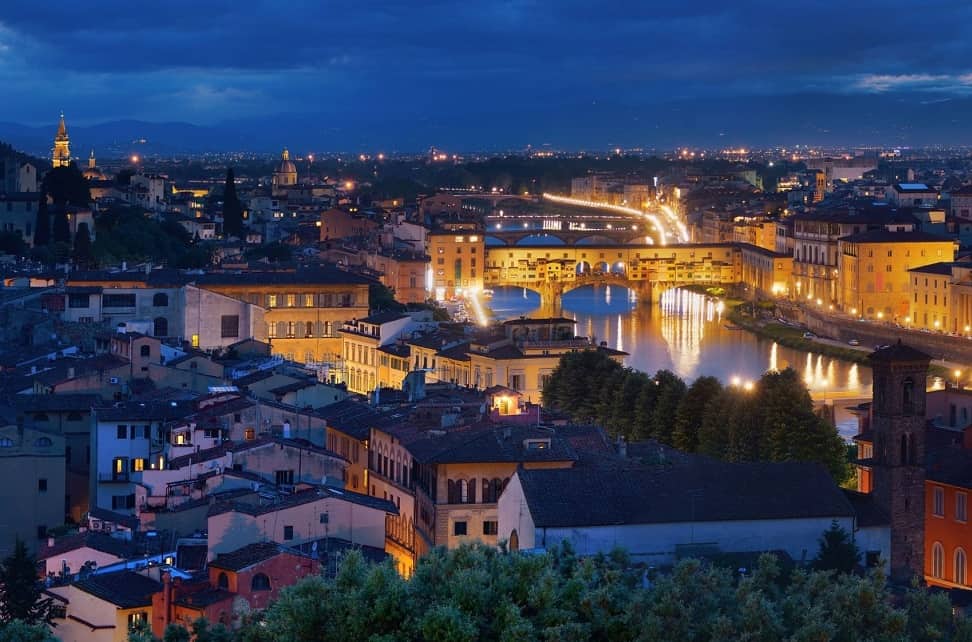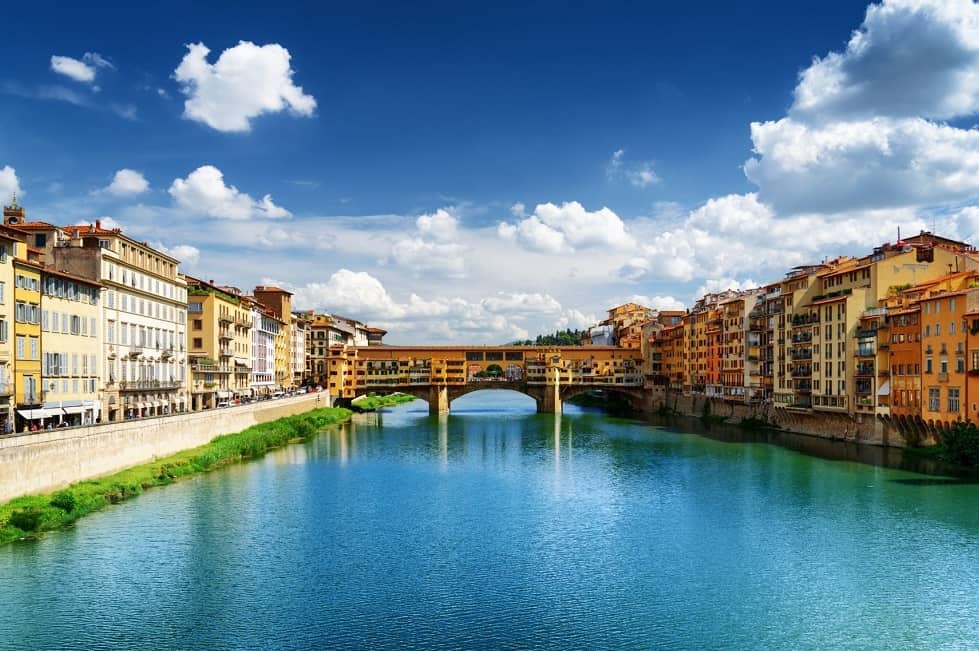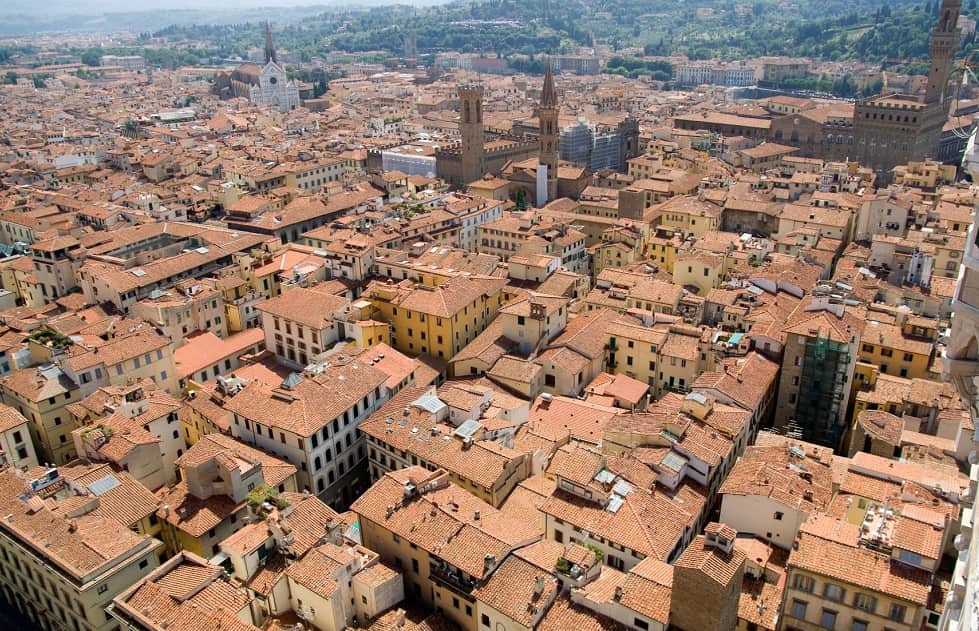The historical centre of Florence is a Unesco World Heritage Site because of its environment, which has remained unchanged over the centuries, and because of the great works of art it contains. Florence, surrounded by the Tuscan hills and crossed by the river Arno, was born from an Etruscan settlement, later transformed into a Roman colony under the name of Florentia (founded in 59 B.C.) Between the 15th and 16th centuries, under the Medici rule, it reached the height of its splendour thanks to its flourishing trade, precious textile production and lively cultural life. Santa Maria del Fiore, the Church of Santa Croce, the Uffizi and Palazzo Pitti are just some of the magnificent works of art that can be visited, as well as finding works by great masters such as Giotto, Brunelleschi, Botticelli, Leonardo Da Vinci, Donatello, Masaccio and Michelangelo. The Florentines have preserved the original building techniques using traditional building materials such as 'pietra forte', 'pietra serena', plaster and frescoes and have respected the city's medieval roots and Renaissance identity. The unique Florentine craftsmanship and traditional shops in the historic centre bear witness to the local past.

From Piazza del Duomo to Piazza della Signoria

The current historic centre of Florence covers 505 hectares and is bounded by the remains of the 14th-century city walls. Its structure is typical of the Roman city and the main decumanus is represented by Via Del Corso which, yesterday as today, with Via dei Calzaiuoli represent the centre of the economic and commercial life of the city. The spiritual centre of Florence is in Piazza del Duomo and Piazza San Giovanni, where the Church of Santa Maria del Fiore and the Baptistery of San Giovanni are located, almost certainly the oldest religious building in the city, embellished with several exceptional works, among which the three bronze doors stand out. The 153 m long Duomo is the fourth largest church in the world, capable of holding up to 30,000 people. The basilica was begun in 1296 by Arnolfo di Cambio but was not completed until 1421, because after his death more than forty years passed before Francesco Talenti proposed and carried out a reworking of the original project, completing it. Brunelleschi's dome was not completed until 1446. The eastern area between Piazza Duomo and Piazza della Signoria, on the other hand, has retained many of its medieval features, and especially along this route are the Palazzo del Bargello, the first public building in Florence's communes, the Badia Fiorentina, a Benedictine monastery founded in 978, Palazzo Gondi, one of the most representative 15th-century Florentine palaces, and Palazzo Pazzi, known as "della Congiura" because it was destined for the family that hatched the plot against the Medici in 1478. An unmissable destination for every tourist is the splendid and famous Piazza della Signoria which, despite the passage of time, has maintained its ancient charm. In this area archaeological excavations have shown the presence of important buildings from the Roman era, while in the Middle Ages the tower houses of the Ghibelline families dominated the square. Since the 14th century this area has become the political centre of the city with Palazzo dei Priori (originally Palazzo Vecchio) and the Loggia della Signoria to which the Uffizi Palace was later added. The wonderful sculptural monuments were only introduced in the second half of the 16th century. Duke Cosimo I de' Medici commissioned Giorgio Vasari to design the Uffizi, the greatest masterpiece of 16th-century Florentine architecture. Construction began in 1560 and was completed in 1565 with the so-called 'Corridoio Vasariano', a secure link with Palazzo Pitti. The palace was born as the seat of the administrative offices of the Duchy and immediately housed part of the grand ducal art collections and other important collections of paintings, thus was born the Uffizi Gallery, the oldest museum of modern Europe in which there are works of the great Italian artists such as Cimabue, Giotto, Masaccio, Perugino, Botticelli, Leonardo, Raphael, Michelangelo, Bellini, Titian, Giorgione, Tintoretto. There are also important Flemish works and paintings from the 17th and 18th centuries, as well as archaeological finds and ancient sculptures, maps and a collection of tapestries.
Bridges over the Arno

The Arno River crosses the city from east to west and a series of bridges connect its two banks, including Ponte Vecchio and Ponte Santa Trinità. The unique Ponte Vecchio with its goldsmiths' workshops fascinates and attracts thousands of tourists every year. It was built in 1345 at the narrowest point of the river on three solid arches. On the middle, an open space with no shops and a beautiful view of the river is a favourite place for a photo as a souvenir of the visit to this particular bridge. Slender and one of the most beautiful in Europe, Ponte S. Trinità leads to Via dei Tornabuoni. It was built by Bartolomeo Ammanati using a daring construction technique, in fact it crosses the Arno with three polycentric arches at the ends of which are four statues representing the seasons. The bridge was destroyed by the Germans in 1944, but was painstakingly rebuilt according to the original design, recovering the collapsed stones from the river. Ponte alla Carraia connects Piazza Goldoni with Piazza Nazario Sauro, while Ponte delle Grazie connects Lungardo Diaz and Lungarno Torrigiani.
Unesco Heritage: criteria

The historic centre of Florence has been a Unesco World Heritage Site since 1982 as it has been defined as "a unique artistic achievement, a masterpiece, the result of continuous creative work over six centuries" with a concentration of works of art known throughout the world as well as several museums including the Archaeological Museum, the Uffizi Gallery and the Pitti Palace. Famous in the world are the Cathedral of Santa Maria del Fiore, the Baptistery, Giotto's Bell Tower, Piazza della Signoria dominated by Palazzo Vecchio and Palazzo degli Uffizi, to name but a few. Since the 15th century, the historic centre of Florence has exerted "a predominant influence on the development of architecture and the monumental arts, first in Italy and then in Europe". after all, it was here that art geniuses such as Michelangelo and Leonardo Da Vinci established themselves. The historical centre of Florence is an exceptional testimony, both as a mercantile city in the Middle Ages and as a Renaissance city, preserving intact streets, loggias, squares and fountains. Florence was an economic and political power in Europe between the 14th and 17th centuries, and it was during these long years that prestigious buildings were erected as a sign of its magnificence. These include Palazzo Strozzi, Palazzo Medici-Riccardi, Palazzo Pitti and the Medici funeral chapels. Finally, Florence is the home of modern Humanism inspired by Poliziano, Pico Della Mirandola, Ficino and others.
About the author
Written on 26/03/2021


Claudia Prezioso
The Historic Centre of Florence, with its narrow alleys, cobbled streets and medieval and Renaissance buildings, has been a Unesco World Heritage Site since 1982.